Grace in the Grotesque
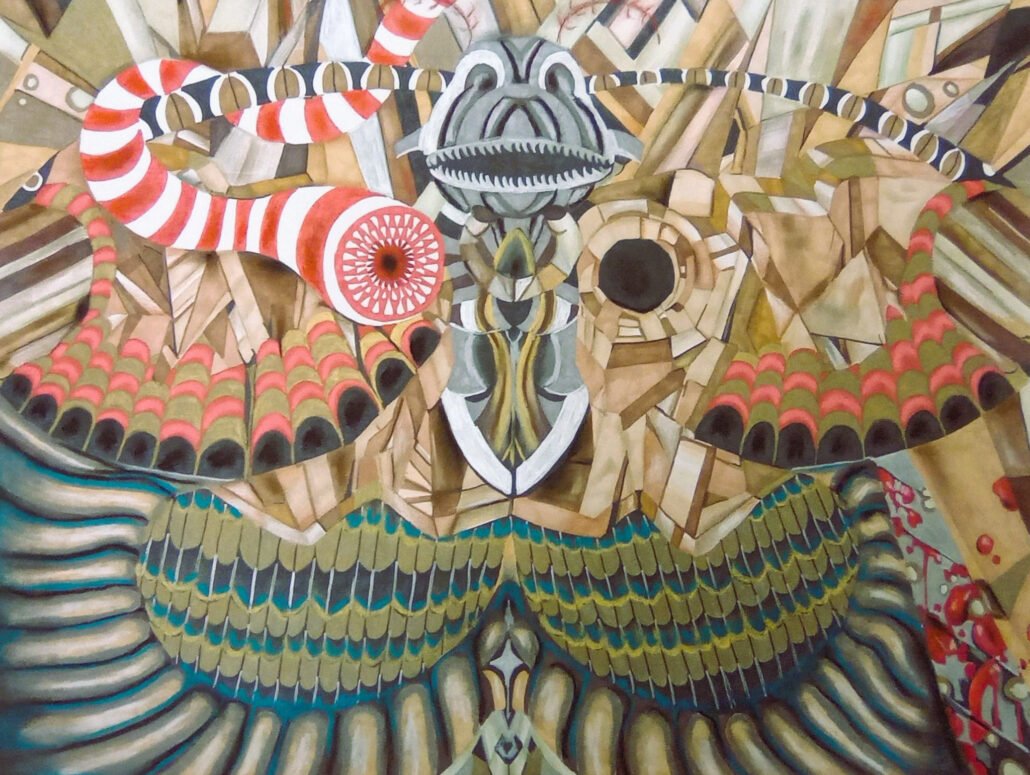
Madam Melva
Mixed-media
December 1, 2025
February 1, 2026
Madam Melva invites you to cross the threshold between the real and the imagined—where radiant color and restless emotion take form.
Created for the 100 Women Artists exhibition at the Dunedin Fine Arts Center in 2024, this piece pays tribute to sculptor Lee Bontecou, whose groundbreaking work combined welded metal and found materials to explore powerful contrasts of strength and vulnerability. The artist interprets Bontecou’s distinctive circular forms and textures through a richly shaded, two-dimensional composition that hints at the surface of aged metal or weathered wood. The result is both a homage and a contemporary reimagining—honoring Bontecou’s bold spirit and her ability to find beauty within the raw and unconventional.
Through her bold juxtapositions of pastel, pencil, and ink, Madam Melva urges a modern renaissance of creative freedom, reminding us that true artistry is not a polite pursuit but a provocative one—meant to spark conversation, challenge perception, and linger long after the gallery lights fade.
Step into the imaginative world of Madam Melva, where surrealism and symbolism collide in a vivid rebellion against the ordinary. Drawing inspiration from visionaries like Dali, Giger, Burton, and Ito, her works blur the line between dream and disquiet, inviting viewers to confront beauty in the bizarre. Each piece serves as both spectacle and statement—an act of defiance against complacency and conformity in art.
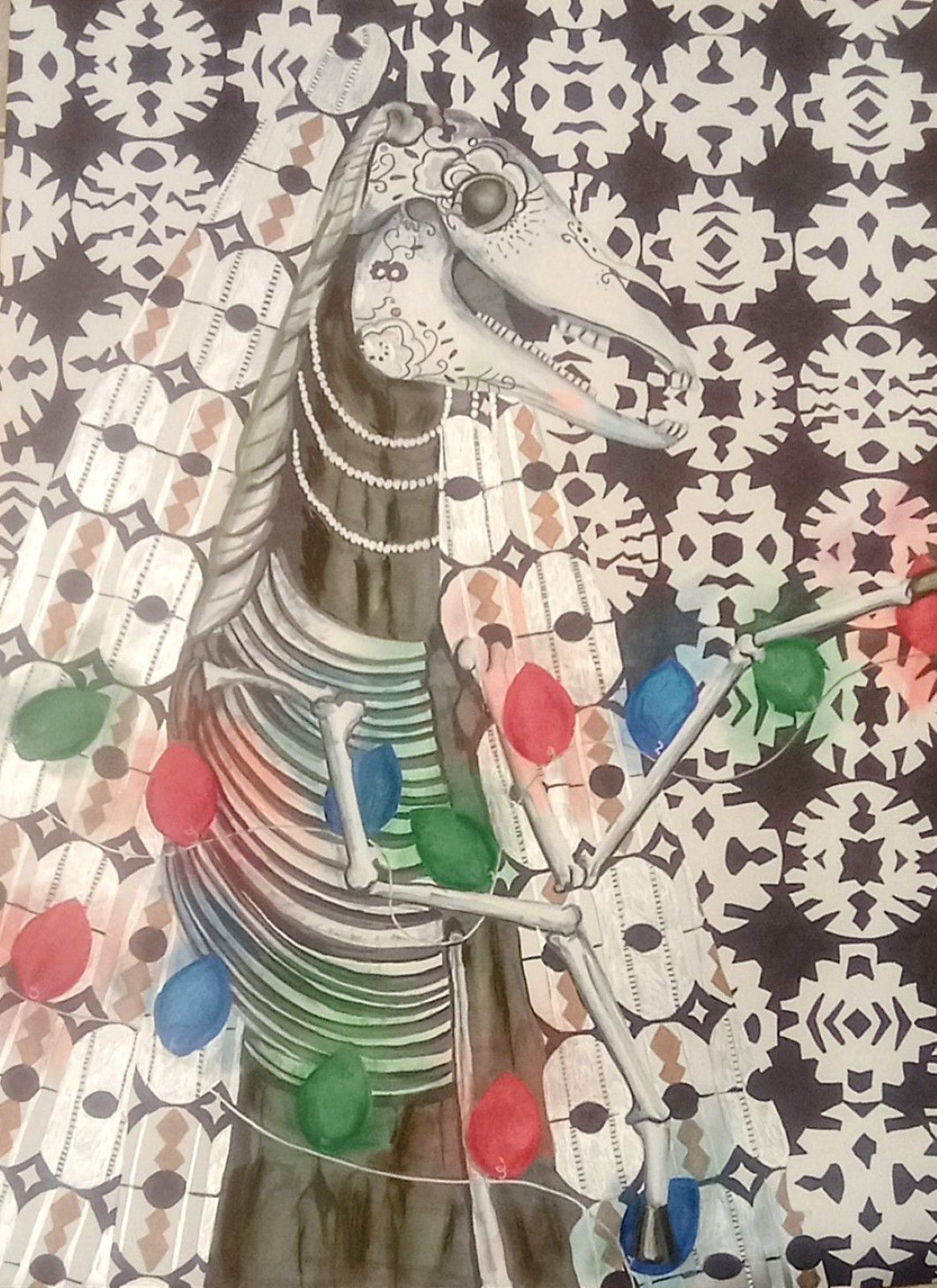
Inspired by Welsh winter folklore, Mari Lwyd reimagines the eerie beauty of the “Grey Mare,” a traditional figure from South Wales that has haunted seasonal celebrations since the early 19th century. Traditionally fashioned from a horse or deer skull draped in ribbons, bells, and fabric, Mari Lwyd accompanies wassailers as they wander from house to house singing and challenging residents to poetic verse.
In this work, the artist captures that haunting duality—both festive and ghostly—through a restrained palette of black, white, and gray, illuminated by strands of glowing Christmas lights. Every snowflake in the background was hand-cut with vintage stencils, reinforcing the delicate craftsmanship and timeless ritual at the heart of this strange and enchanting winter tradition.
The Artist
Working under the pseudonym Madam Melva, Florida-based artist Pamela Torres transforms unconventional materials—pastel, colored pencil, marker, and even liquid paper—into striking surrealist compositions that fuse whimsy with unease. A Monmouth University graduate originally from New Jersey, she has steadily built a reputation for bold, conversation-starting imagery that reflects her fascination with the fantastical and the grotesque. Her work has been exhibited throughout Florida and featured internationally in digital and print publications, earning recognition from Influx Gallery, Pearview Gallery, and Light Space & Time, among others. Influenced by Salvador Dali, H.R. Giger, Tim Burton, and Junji Ito, Madam Melva creates art that refuses to stay quiet—art that challenges, provokes, and invites viewers to question what lies beneath the beautiful and the bizarre.
Drawing inspiration from Harlan Ellison’s dystopian short story of the same title, this work channels the author’s haunting vision of a world consumed by technology and stripped of humanity. The artist translates Ellison’s nightmarish landscape—where consciousness endures beyond mercy—into a visceral visual form. What emerges is less a depiction of horror than an exploration of endurance itself: the desperate will to move, to think, to exist, even within the confines of despair. Through abstraction and symbolism, the piece reflects on the fragility of the human condition in an age where the line between creation and control has irrevocably blurred.
"I want each one of my drawings to be a conversation piece; one that viewers will remember and talk about long after leaving the room."
In this surreal reimagining of Medusa, the artist transforms the mythic Gorgon into a figure entwined with her own desolate landscape. Drawing inspiration from Salvador Dalí’s dreamlike terrains, Medusa appears fused with a scorching desert—her serpentine tail coiling across scaly sand as she steadies herself on towering crutches. The piece captures both agony and defiance, conveying human emotion without revealing a face.
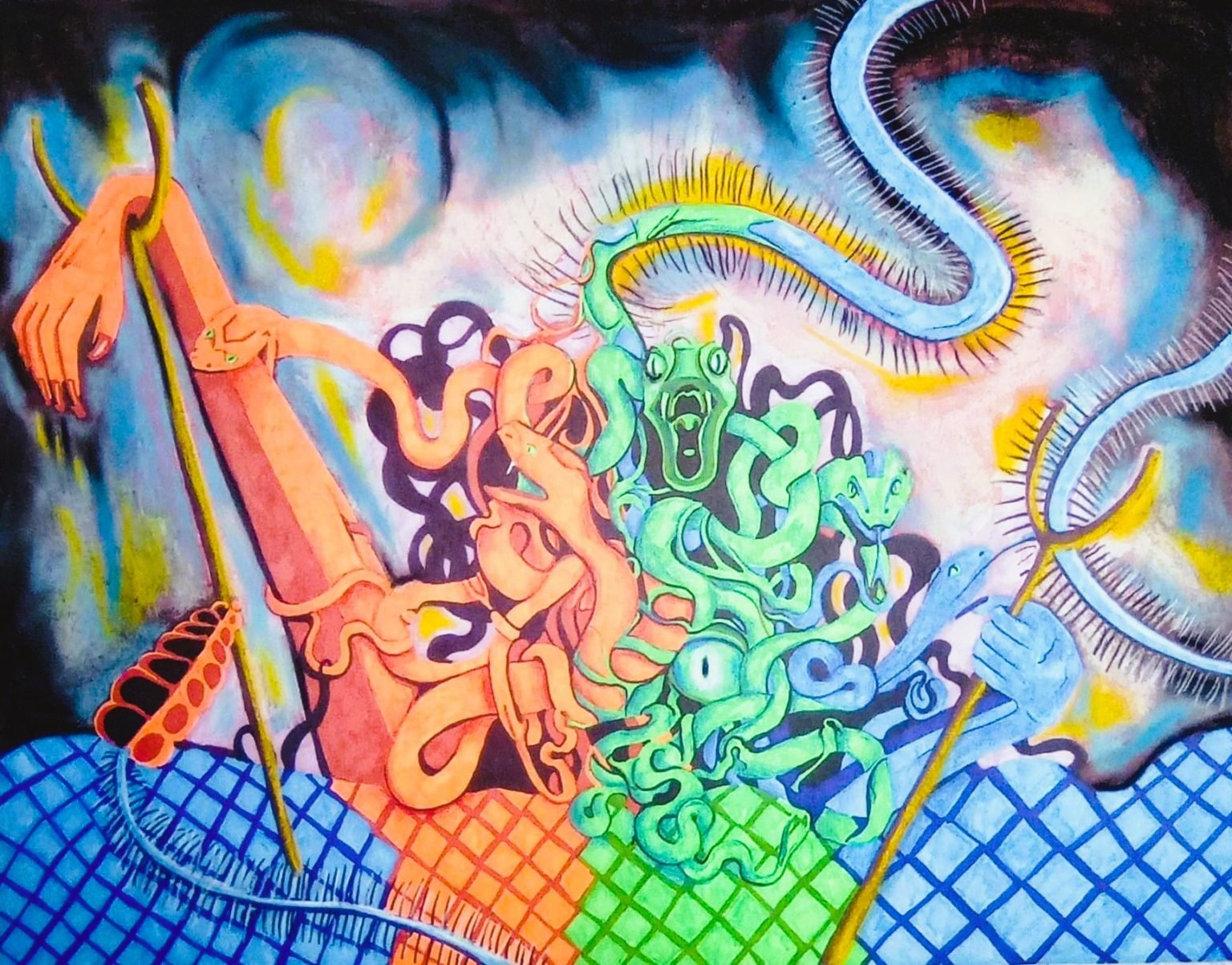
Her imagery obeys a private logic, one more emotional than rational. Objects transform, scales shift, and time folds in on itself. We are left with the uncanny sense that the impossible is quietly insisting on being real.
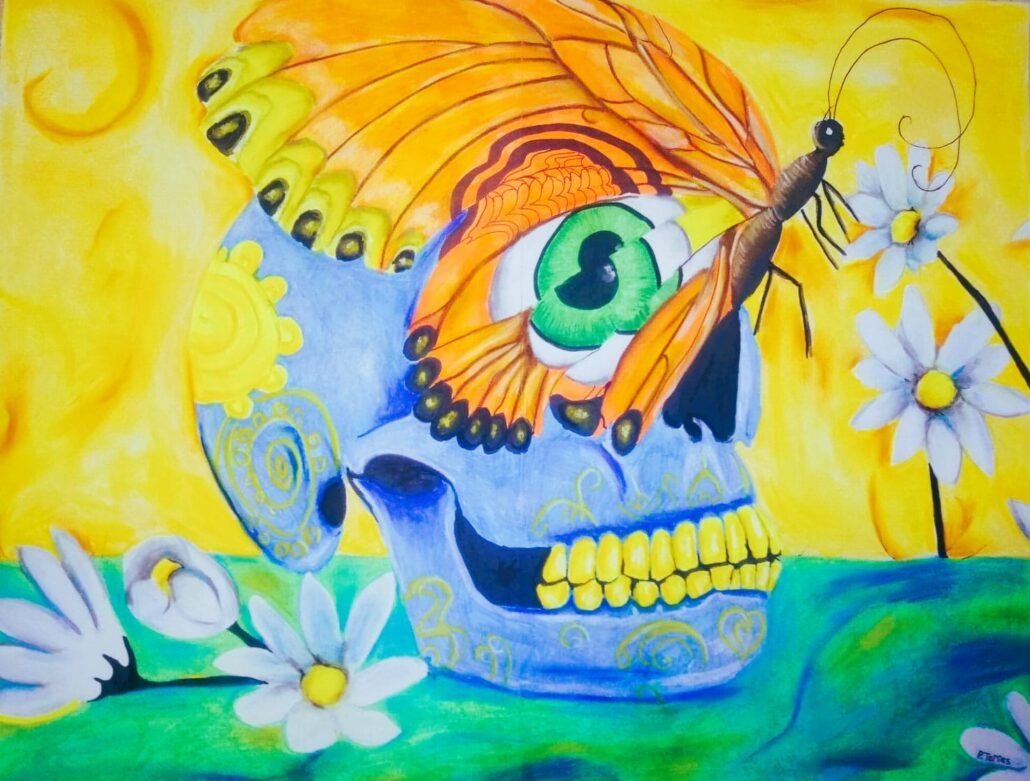
First gaining recognition in early 2020, Madam Melva’s Butterfly Blessings earned third place in St. Pete Lofts’ annual Valentween exhibition, where it was personally selected by the famed TV horror host Dr. Paul Bearer II. “Eyeballs were the theme and, while inspired by Salvador Dali’s desert landscapes, I sketched an iris and pupil patterned on a butterfly’s wing that’s fluttering over a grinning sugar skull decorated with Aztec gold and surrounded by a field of daisies.” This early success marked a pivotal moment in the artist’s emergence—introducing her distinctive blend of dark whimsy and surreal beauty to a wider audience just before the world entered its own season of uncertainty.
Madam Melva's works resist conclusion. They don’t tell us what to think or feel, but offer pathways — sometimes lit, sometimes obscure — for our own interpretations to take root.
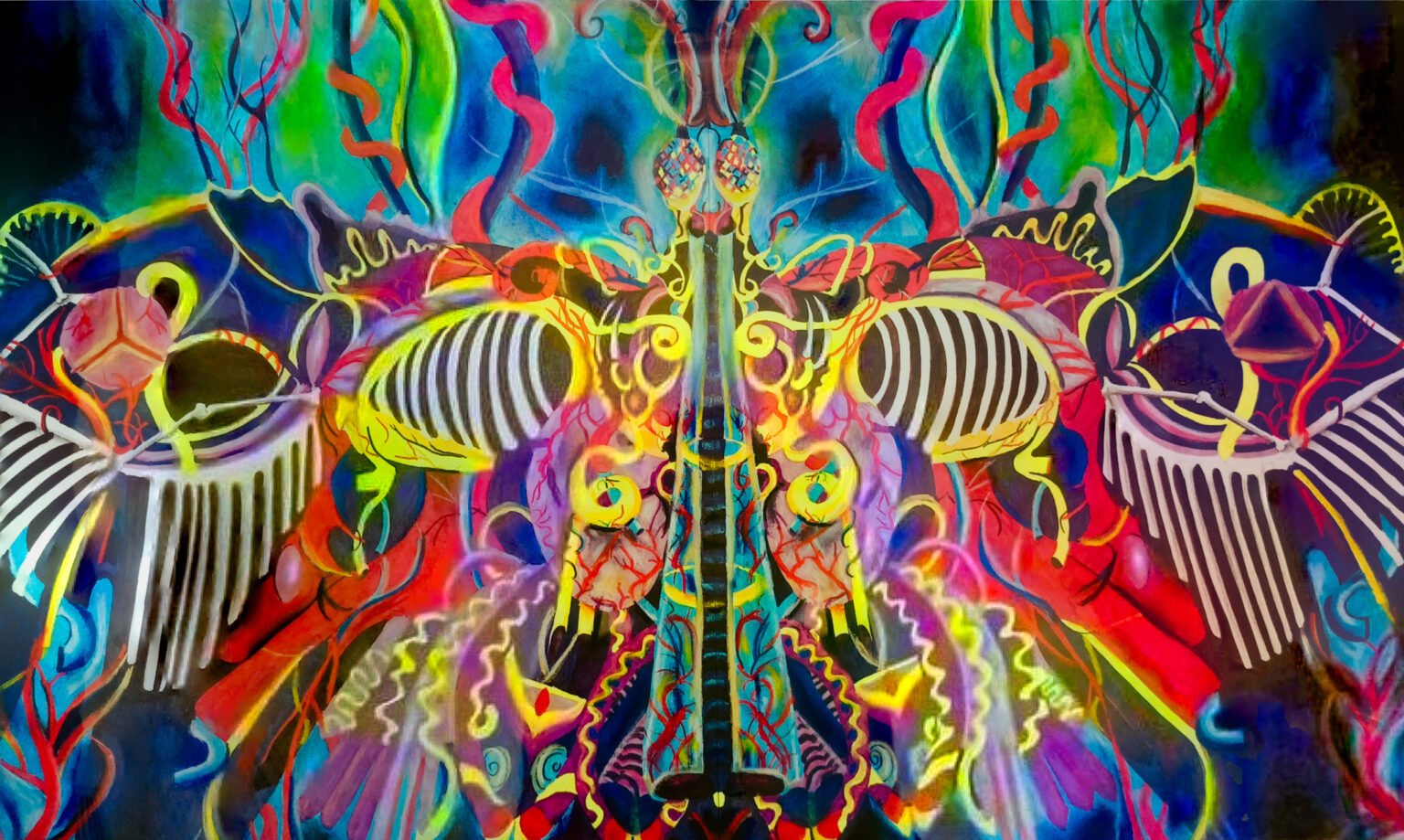
In Lymphadoptera, the artist merges anatomy and entomology, blending the human lymphatic system with the delicate symmetry of Lepidoptera—the order of insects that includes butterflies and moths. Spanning two sheets of Bristol board, the composition unfolds through intersecting diagonal lines that reveal a wingspan woven from blood vessels, rib bones, heart valves, and organs. The glowing neon palette heightens its surreal tension, evoking the vivid color schemes and stylized horror of Italian giallo films—cinema known for its haunting beauty, psychological intensity, and fascination with the macabre. The result is a piece that feels both scientifically precise and disturbingly alive.
Many of her creations shimmer with a captivating allure, drawing the viewer in with color and form that seem almost alive. Yet beneath that surface brilliance, a quiet tension lingers — the sense that something unspoken lies just beyond reach. The interplay between beauty and unease runs through the entire collection, reminding us that what dazzles the eye can also conceal what the spirit cannot mend. Together, these works suggest that elegance and discomfort are not opposites, but intertwined truths within the artist’s vision.
Slider image backstory: We Belong (snuggling couple): At once intimate and cinematic, this work was inspired by a personal photograph of the artist and her husband at home, reimagined through the visual language of classic horror cinema. The title references the final scene of Bride of Frankenstein (1935), in which Boris Karloff delivers the haunting line, “We belong dead.” Within this context, the phrase becomes an affirmation of endurance and shared humanity rather than despair. Created after her husband’s long and courageous recovery from cancer and amputation, the piece reflects love’s persistence amid fragility—the ways in which resilience and devotion transform even life’s darkest moments into art.
Drawing inspiration from the striking symmetry of the Saturnia pavonia—the emperor moth—this is the second large-scale butterfly work from Madam Melva. Her art transforms natural grace into something mythic and strange—a creature caught between elegance and menace—its wings more dragon than moth, as if nature itself had taken a daring turn toward the fantastical.
Metallic gold and silver accents glimmer across its surface, animating scales that seem to shimmer and shift with the light. The juxtaposition of “diamond scales, sharp teeth, and a serpentine tongue…bring the lizard-like wings to life, as if mutated from a komodo dragon”.

In Madam Melva’s world, recollection is never fixed. Her images feel like fragments from a shared dream — half memory, half myth. They ask whether what we remember is truth, or simply the story we’ve decided to keep.

In “Cruelty Brought Thee Orchids”, the artist revisits the infamous legend of 17th-century noblewoman Elizabeth Bathory—known as the “Blood Countess”—whose beauty and power were overshadowed by tales of unspeakable cruelty. Drawing on the psychological intensity of Edvard Munch and Francis Bacon, the portrait fractures into dual faces: one human, the other grotesquely distorted by sadism and myth. The title, borrowed from a song by the British black-metal band Cradle of Filth, underscores the work’s dark romanticism and exploration of corruption, vanity, and violence through a modern lens.
"This is without a doubt the most abstract piece I ever drew."
The Wolf, the Bat and the Moaning Mist channels the gothic tension between sanctity and sin, drawing inspiration from classic vampire lore, most notably Bram Stoker’s Dracula. Here, the artist envisions a visceral collision of faith and fear: a screeching blood-red mouth, with prominent fangs, screams in silence as they are pierced from all sides by radiant, glowing crosses.
Surrounding the scene, sunlight fractures through an intricate, expanding prism of stained-glass church windows—as if transforming horror into reverence, and violence into illumination. The result is a haunting meditation on redemption, suffering, and the divine light that exposes both.

Each composition reveals a fascination with transformation. Beneath the surface beauty lies something shifting and alive — a suggestion that what we see is only the thinnest layer of meaning.
In Refracting God, Madam Melva pays homage to shock rocker Marilyn Manson, transforming musical provocation into visual symbolism. The title nods to Manson’s “Reflecting God” from Antichrist Superstar, while the composition draws direct inspiration from a lyric in The Golden Age of Grotesque: “I’m a diamond that is tired of all the faces I’ve acquired.”Within a precisely drawn, faceted diamond, multiple fragmented portraits of Manson—sourced from 1990s press photos—converge and distort. Colored pencil, marker, and soft pastel fuse to create a surface that both shimmers and unsettles, reflecting the tension between identity, fame, and self-erasure at the heart of Manson’s persona.
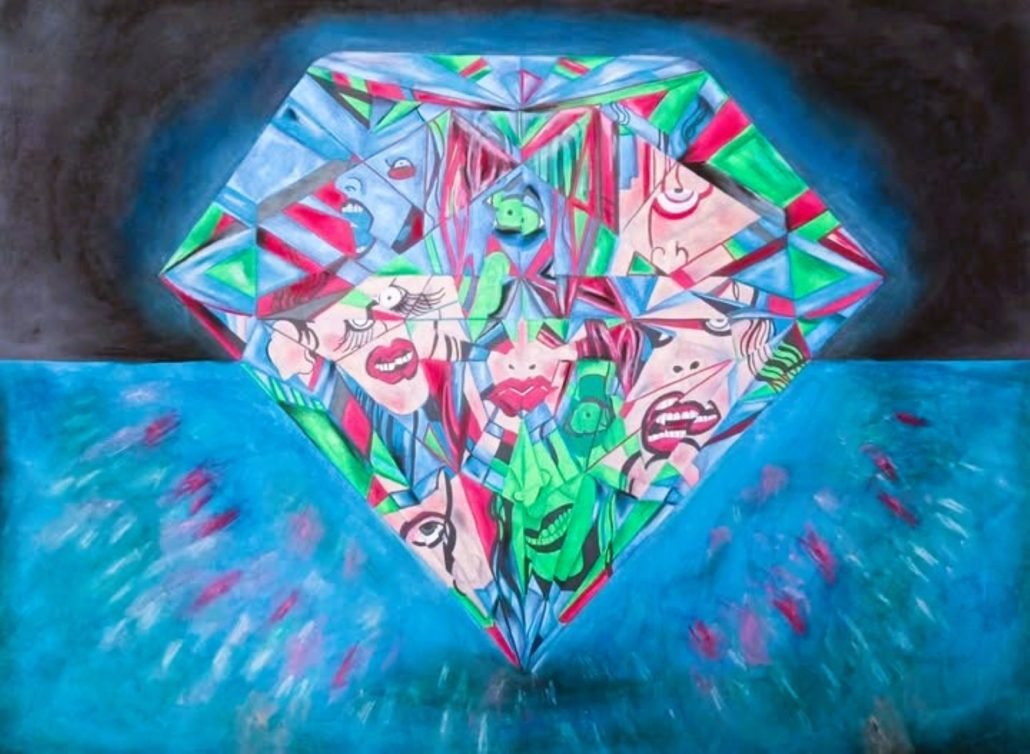
Madam Melva
Use the INQUIRE buttons to access that artist’s contact form. All purchase inquiries are sent directly to the artist.
Inspired by what you’ve seen? You could be our next featured artist! | APPLY TODAY for a solo exhibition opportunity with Sommer Haus Gallery.


